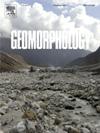Delineating sediment compartment boundaries in an urbanised embayment for geomorphic management of decadal-scale coastal dynamics
IF 3.1
2区 地球科学
Q2 GEOGRAPHY, PHYSICAL
引用次数: 0
Abstract
Coastal sediment compartments are used for quantifying landform dynamics for the purposes of coastal management. They are defined as primary, secondary and tertiary compartments. The smallest unit, the tertiary compartment, encompasses sediment movement over a decade. This scale is viewed as most relevant for managers, however defining them has proven difficult due to complexity of local geomorphology. In this paper we analyse the delineation of tertiary compartments and their boundaries in Australia and test their applicability in Port Phillip Bay. Sediment movement in a compartment is assessed based on geomorphic features related to wind and hydrodynamic processes, such as surf zone bars and aeolian dunes. Classifying tertiary compartments can be difficult for long (kilometre-scale) continuous beaches where sediment transfer from opposite ends does not occur in a decade. Management activities especially rock walls, groynes and training walls in enclosed bays also complicates the delineation of compartments. A five-point scale is developed for compartment boundaries from closed, leaky (i), leaky (ii), leaky (iii), to open. In the case of shorelines in urbanised areas, engineered structures most commonly define compartments. It is also found that tertiary compartment extent cannot be considered static over decadal scales.
求助全文
约1分钟内获得全文
求助全文
来源期刊

Geomorphology
地学-地球科学综合
CiteScore
8.00
自引率
10.30%
发文量
309
审稿时长
3.4 months
期刊介绍:
Our journal''s scope includes geomorphic themes of: tectonics and regional structure; glacial processes and landforms; fluvial sequences, Quaternary environmental change and dating; fluvial processes and landforms; mass movement, slopes and periglacial processes; hillslopes and soil erosion; weathering, karst and soils; aeolian processes and landforms, coastal dunes and arid environments; coastal and marine processes, estuaries and lakes; modelling, theoretical and quantitative geomorphology; DEM, GIS and remote sensing methods and applications; hazards, applied and planetary geomorphology; and volcanics.
 求助内容:
求助内容: 应助结果提醒方式:
应助结果提醒方式:


